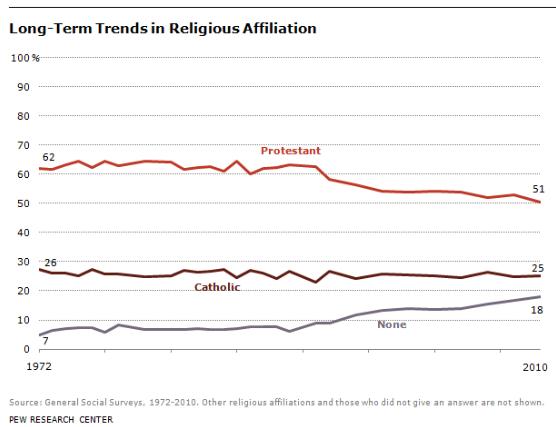 Excerpt from Pew Forum on Religion and Public Life report “Nones” on the rise.
Excerpt from Pew Forum on Religion and Public Life report “Nones” on the rise.
While the ranks of the unaffiliated have grown significantly over the past five years, the Protestant share of the population has shrunk. In 2007, 53% of adults in Pew Research Center surveys described themselves as Protestants. In surveys conducted in the first half of 2012, fewer than half of American adults say they are Protestant (48%). This marks the first time in Pew Research Center surveys that the Protestant share of the population has dipped significantly below 50%.
The decline is concentrated among white Protestants, both evangelical and mainline. Currently, 19% of U.S. adults identify themselves as white, born-again or evangelical Protestants, down slightly from 21% in 2007. And 15% of adults describe themselves as white Protestants but say they are not born-again or evangelical Christians, down from 18% in 2007.5 There has been no change in minority Protestants’ share of the population over the past five years.
nones-exec-7
These findings represent a continuation of long-term trends.6 The General Social Surveys (GSS), conducted by the National Opinion Research Center at the University of Chicago for roughly four decades, show that the number of religiously unaffiliated adults remained below 10% from the 1970s through the early 1990s. The percentage of religiously unaffiliated respondents began to rise noticeably in the 1990s and stood at 18% in the 2010 GSS.
The Protestant share of the population, by contrast, has been declining since the early 1990s. In the GSS, about six-in-ten adults identified as Protestants in the 1970s and 1980s. By 2000, however, 54% of GSS respondents were Protestant. And in the 2010 GSS, 51% of respondents identified themselves as Protestants.
The Catholic share of the population has been roughly steady over this period, in part because of immigration from Latin America.7
Disclaimer: Articles featured on Oregon Report are the creation, responsibility and opinion of the authoring individual or organization which is featured at the top of every article.


